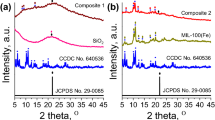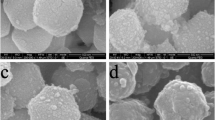Abstract
The mesoporous silica nanoparticles (MSN) was modified by salicylaldimine, furfuralimine, and benzaldehyde imine, respectively, denoted as Sal-MSN, Fur-MSN, and Ben-MSN for methyl eugenol (Me) delivery by one-step method. The results confirmed that Me was successfully adsorbed by Schiff base mesoporous silica, which maintained regular hexagonal pore structure. Me is distributed in amorphous state in the pores of the mesoporous silica indicated by differential scanning calorimeter (DSC) curves. Schiff base modification strengthened the interaction between Me and mesoporous silica, leading to its higher sustained-release performance and the disappearance of sudden release in sustained-release performance comparing with Me-MSN before Schiff base modification. Me and Me-MSN were most consistent with the First-order kinetic and logistic equation, respectively. After Schiff base modification, Me-Sal-MSN, Me-Fur-MSN, and Me-Ben-MSN were most consistent with Korsmeryer–Peppas kinetic equation. Therefore, the difference of Me concentration was no longer the main control factor of sustained-release system after Schiff base modification. In the attraction of Bactrocera dorsalis test, the lure efficiency for per unit Me for Me-MSN, Me-Sal-MSN, Me-Fur-MSN, and Me-Ben-MSN equal to 2.83, 3.31, 3.32, 4.24 times of pure Me. After Schiff base modification, the samples showed higher lure efficiency due to their ideal sustained-release performance without sudden release. In short, the lure efficiency of Me was improved by the Schiff base mesoporous silica sustained-release system, in the meanwhile its service life was also prolonged.

Highlights
-
The mesoporous silica nanoparticles (MSN) was modified by Schiff base through one-step method
-
Schiff base modification strengthened the interaction between methyl eugenol (Me) and mesoporous silica, leading to the disappearance of sudden release in sustained-release performance
-
In the attraction of Bactrocera dorsalis test, the samples showed higher lure efficiency after Schiff base modification










Similar content being viewed by others
References
Irfan SA, Razali R, Kushaari K, Mansor N, Azeem B, Versypt AN (2018) A review of mathematical modeling and simulation of controlled-release fertilizers. J Control Release 271:45–54
Kumar S, Nehra M, Dilbaghi N, Marrazza G, Hassa AA, Kim KH (2019) Nano-based smart pesticide formulations: emerging opportunities for agriculture. J Control Release 294:131–153
He Q, Gao Y, Zhang L, Zhang Z, Gao F, Ji X, Li Y, Shi J (2011) A pH-responsive mesoporous silica nanoparticles-based multi-drug delivery system for overcoming multi-drug resistance. Biomaterials 32:7711–7720
Chen H, Lin Y, Zhou H, Zhou X, Gong S, Xu H (2016) Synthesis and characterization of chlorpyrifos/copper(ii) schiff base mesoporous silica with pH sensitivity for pesticide sustained release. J Agric Food Chem 64:8095–8102
Zhai QZ, Hu WH, Huang BL, Wang CY (2012) Synthesis and characterization of mesoporous SBA-15/propranolol hydrochloride for controlled drug release study. J Sol-Gel Sci Techn 63:435–444
Popat A, Hartono SB, Stahr F, Liu J, Qiao SZ, Lu G (2011) Mesoporous silica nanoparticles for bioadsorption, enzyme immobilisation, and delivery carriers. Nanoscale 3:2801–2818
Wang L, Zhao W, Tan W (2008) Bioconjugated silica nanoparticles: Development and applications. Nano Res 1:99–115
Wibowo D, Zhao CX, Peters BC, Anton PJM (2014) Sustained release of fipronil insecticide in vitro and in vivo from biocompatible silica nanocapsules. J Agr Food Chem 62:12504–12511
Campos EVR, Oliveira JLD, Fraceto LF, Singh B (2015) Polysaccharides as safer release systems for agrochemicals. Agron Sustain Dev 35:47–66
Wan MM, Li YY, Yang T, Zhang T, Sun XD, Zhu JH (2016) In situ loading of drugs into mesoporous silica SBA-15. Chem-Eur J 22:6294–6301
Gao C, Izquierdo-Barba I, Nakase I, Futaki S, Ruan J, Sakamoto K, Kuroda K, Terasaki O, Che S (2009) Mesostructured silica based delivery system for a drug with a peptide as a cell-penetrating vector. Micropor Mespor Mat 122:201–207
Tournepeteilh C, Begu S, Lerner DA, Galarneau A, Lafont U, Devoiselle JM (2011) Sol-gel one-pot synthesis in soft conditions of mesoporous silica materials ready for drug delivery system. J Sol-Gel Sci Techn 61:455–462
Zheng X, Chen F, Zhang J, Cai K (2016) Silica-assisted incorporation of polydopamine into the framework of porous nanocarriers by a facile one-pot synthesis. J Mater Chem B 4:2435–2443
Zhou M, Du X, Li W, Li X, Huang H, Liao Q, Shi B, Zhang X, Zhang M (2017) One-pot synthesis of redox-triggered biodegradable hybrid nanocapsules with a disulfide-bridged silsesquioxane framework for promising drug delivery. J Mater Chem B 5:4455–4469
Wan MM, Li YY, Yang T, Zhang T, Sun XD, Zhu JH (2016) In situ loading of drugs into mesoporous silica SBA-15. Chemistry 22:6294–6301
Chen H, Hu J, Zhou H, Zhou X, Xu H (2019) One step synthesis, characterization of F127-Mn+-chlorpyrifos mesoporous silica for sustained release system with pH sensitivity. J Macromol Sci A 56:34–41
Dharanivasan G, Sithanantham S, Kannan M, Chitra S, Kathiravan K, Janarthanan S (2017) Metal oxide nanoparticles assisted controlled release of synthetic insect attractant for effective and sustainable trapping of fruit flies. J Clust Sci 28:2167–2183
Kresge CT, Leonowicz ME, Roth WJ, Vartuli J, Beck J (1992) Ordered mesoporous molecular sieves synthesized by a liquid-crystal template mechanism. Nature 359:710–712
Han L, Gao C, Wu X, Chen Q, Shu P, Ding Z, Che S (2011) Anionic surfactants templating route for synthesizing silica hollow spheres with different shell porosity. Solid State Sci 13:721–728
Jobdeedamrong A, Jenjob R, Crespy D (2018) Encapsulation and release of essential oils in functional silica nanocontainers. Langmuir 34:13235–13243
Vallet‐Regí M, Balas F, Arcos D (2007) Mesoporous materials for drug delivery. Angew Chem Int Ed 2007 46:7548–7558
Vallet-Regi M, Rámila A, Real RPD, Perez-Pariente J (2000) A new property of MCM-41: drug delivery system. Chem Mater 13:308–311
Rámila A, Muñoz B, Pérez-Pariente J, Vallet-Regí J (2003) Mesoporous MCM-41 as drug host system. J Sol-Gel Sci Techn 26:1199–1202
Kang J, Park J, Kim JH, Lee CG, Kim SB (2016) Surface functionalization of mesoporous silica MCM-41 with 3-aminopropyltrimethoxysilane for dye removal: kinetic, equilibrium, and thermodynamic studies. Desalin Water Treat 57:7066–7078
Yue Q, Li J, Zhang Y, Cheng X, Chen X, Pan P, Su J, Elzatahry AA, Alghamdi A, Deng Y, Zhao D (2017) Plasmolysis-inspired nanoengineering of functional yolk-shell microspheres with magnetic core and mesoporous silica shell. J Am Chem Soc 139:15486–15493
Hartono SB, Qiao SZ, Jack K, Ladewig BP, Hao Z, Lu GQ (2009) Improving adsorbent properties of cage-like ordered amine functionalized mesoporous silica with very large pores for bioadsorption. Langmuir 25:6413–6424
Kruk M, Jaroniec M (2001) Gas adsorption characterization of ordered organic−inorganic nanocomposite materials. Chem Mater 13:3169–3183
Shen Z, Zhou H, Chen H, Xu H, Zhou X (2018) Synthesis of Nano-zinc oxide loaded on mesoporous silica by coordination effect and its photocatalytic degradation property of methyl orange. Nanomaterials 8:317
He L, Huang Y, Zhu H, Zheng W, Wong Y, Chen T (2014) Cancer-targeted monodisperse mesoporous silica nanoparticles as carrier of Ruthenium polypyridyl complexes to enhance theranostic effects. Adv Funct Mater 24:2754–2763
Li Y, Shubina TE, Chen M, Shi Z, Schmid M, Sterinruck HP, Gottfried JM, Lin N (2012) Coordination and metalation bifunctionality of Cu with 5,10,15,20-tetra(4-pyridyl)porphyrin: toward a mixed-valence two-dimensional coordination network. J Am Chem Soc 134:6401–6408
Chen H, Rui Z, Ji H (2014) Monolith-like TiO2 nanotube array supported Pt catalyst for HCHO removal under mild conditions. Ind Eng Chem Res 53:7629–7636
Bajpai VK, Baek KH (2016) Biological efficacy and application of essential oils in foods-a review. J Ess Oil Bear Pl 19:1–19
Raza W, Haque MM, Muneer M (2014) Synthesis of visible light driven ZnO: Characterization and photocatalytic performance. Appl Surf Sci 322:215–224
Ogieglo W, Wormeester H, Wessling M, Benes NE (2013) Temperature-induced transition of the diffusion mechanism of n-hexane in ultra-thin polystyrene films, resolved by in-situ spectroscopic ellipsometry. Polymer 54:341–348
Caravieri BB, Oliveira PFD, Furtado RA, Tavares DC, Nassar EJ, Ciuffi KJ, Molina EF (2014) Solubility enhancement of ibuprofen using tri-ureasil-PPO hybrid: structural, cytotoxic, and drug release investigation. J Sol-Gel Sci Techn 72:627–636
Acknowledgements
This research was supported by National Natural Science Foundation of China (Grant No. 21576303, 21606262), Natural Science Foundation of Guangdong Province (Grant No. 2016A030313375, 2017A030311003), Science and Technology Program of Guangzhou, China (Grant No. 201707010473, 201903010011).
Author information
Authors and Affiliations
Corresponding authors
Ethics declarations
Conflict of interest
The authors declare that they have no conflict of interest.
Additional information
Publisher’s note Springer Nature remains neutral with regard to jurisdictional claims in published maps and institutional affiliations.
Rights and permissions
About this article
Cite this article
Chen, H., Li, J., Shen, Z. et al. One-step synthesis of methyl eugenol/Schiff base mesoporous silica nanoparticles sustained-release performance with high lure efficiency. J Sol-Gel Sci Technol 92, 723–735 (2019). https://doi.org/10.1007/s10971-019-05134-9
Received:
Accepted:
Published:
Issue Date:
DOI: https://doi.org/10.1007/s10971-019-05134-9




